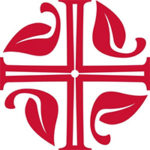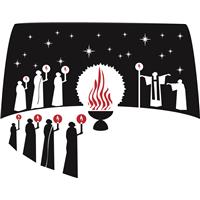Today’s post is written by Julie Grindle, Assistant to the Bishop for  Candidacy and Mobility in the Upstate New York Synod of the ELCA. A past president of the Association of Lutheran Church Musicians (ALCM), Julie also served on the Hymnody Working Group for All Creation Sings.
Candidacy and Mobility in the Upstate New York Synod of the ELCA. A past president of the Association of Lutheran Church Musicians (ALCM), Julie also served on the Hymnody Working Group for All Creation Sings.
This post was previously published in February 2021. It has been updated by the author to reflect our context in March 2022.
New Fire. Easter Proclamation. Ancient stories. Baptismal waters. Bread and wine. This is the night. As you plan worship for the Vigil of Easter, All Creation Sings offers many and various ways for us to sing the centrality of our faith.
We are now two years into the pandemic, and it seems the more things change, the more they stay the same. Many churches are lifting mask restrictions and singing fully as an assembly, while others are only just now coming back together in person, with masks and no singing, except perhaps by a select few musical leaders. Despite these challenges this remains fertile ground for exploring the new resources in All Creation Sings.
The resource is still new to many, and because the assembly is only now coming back together regularly, I strongly suggest that instead of choosing a lot of new material for this year’s Vigil, you select one or two of the new songs and hymns highlighted, and spend some time introducing it/them to the assembly, in whatever form it/they will be used at your Vigil. Perhaps short videos at the beginning or end of Sunday worship can begin acquainting worshippers with the new material. You could discuss the text in depth in a forum then listen to the melody played by an instrument or sung by a soloist, or possibly use the hymn during the upcoming Easter season, preparing the congregation now for next year’s Vigil, while taking advantage of the richness of the texts and themes this year. With those caveats in place, and the health of your congregation as your priority, I join you in looking forward to the time when we join all creation in singing together again, both now as the assembled people of God, and when we are gathered with all the saints at the great feast of the Lamb.
Once ![]() the new fire is lit and the Easter Proclamation has been sung, we gather to proclaim the ancient stories. Many hymns and songs in All Creation Sings align with the suggested sung responses found in Sundays and Seasons. The Creation story (Gen. 1:1-2:4a) has at least three possibilities, all in differing styles. The first, “Earth is full of wit and wisdom” (#1064), explores God’s love of the creatures created under God’s discerning eye, including the roly-poly, the penguin and the platypus. “Before the waters nourished earth” (#1049) explores God’s love and lament for creation, and God’s intention to bring restoration to it. Finally, with “In sacred manner” (#1071) we are reminded that we are to love God’s creation as God loves it and treat it accordingly.
the new fire is lit and the Easter Proclamation has been sung, we gather to proclaim the ancient stories. Many hymns and songs in All Creation Sings align with the suggested sung responses found in Sundays and Seasons. The Creation story (Gen. 1:1-2:4a) has at least three possibilities, all in differing styles. The first, “Earth is full of wit and wisdom” (#1064), explores God’s love of the creatures created under God’s discerning eye, including the roly-poly, the penguin and the platypus. “Before the waters nourished earth” (#1049) explores God’s love and lament for creation, and God’s intention to bring restoration to it. Finally, with “In sacred manner” (#1071) we are reminded that we are to love God’s creation as God loves it and treat it accordingly.
The other readings have excellent offerings to choose from for musical responses. Just a few possibilities are:
Reading 4 (Exod. 14:10-31; 15:20-21): “Who is like our God /Quién como Jehová” (#1098)
Reading 5 (Isa. 55:1-11): “Surely God is my salvation” (#926)
Reading 6 (Proverbs 8:1-8, 19-21; 9:4b-6): “Come and seek the ways of wisdom” (#971)
Reading 9 (Zeph. 3:14-20): “The earth adorned in verdant robe” (#1068)
 For the Procession to the Font, there are many possibilities depending on how much liturgical movement there is and what style of music you would like. If you are celebrating baptisms, “Take me to the water,” an African American spiritual (#957) and “God of promise, let these signs of grace”, a new composition from Paul Damico-Carper (#959), are excellent possibilities. If there are Affirmations of Baptism or a Thanksgiving at the Font, “Come to the water of life” (#955) has a beautiful text reminding us that the font is where we should look to find justice, mercy, and love.
For the Procession to the Font, there are many possibilities depending on how much liturgical movement there is and what style of music you would like. If you are celebrating baptisms, “Take me to the water,” an African American spiritual (#957) and “God of promise, let these signs of grace”, a new composition from Paul Damico-Carper (#959), are excellent possibilities. If there are Affirmations of Baptism or a Thanksgiving at the Font, “Come to the water of life” (#955) has a beautiful text reminding us that the font is where we should look to find justice, mercy, and love.
When it is time for the Setting of the Table, there are texts that are perfect for an evening liturgy, especially the Vigil, because they reflect the joyousness of God’s salvific yet unseen work in darkness. Hymns that reflect this include “Womb of life and source of being” (#948) and “In a deep unbounded darkness” (#1093). A hymn that helps us move liturgically from baptism to Paschal eucharist is “To Christ belong, in Christ behold” (#958). Susan Briehl’s text reminds us that “the buried grain springs forth again with fruit one hundred-fold.” And in the second stanza we sing of this night when, “the binding shroud is here released, the veil of sin and grief, and in their place a wreath of grace and robes of joy and peace.”
During communion I encourage you to use other new hymns that combine the elements of story, water and meal that make this liturgy so unique and central to the liturgical life of the church. “Woman, weeping in the garden” (#935) is a lovely response to John’s Easter gospel. “Lift up your heads” (#1032), while originally written for Easter 2, works beautifully on this night – “O taste and see what once was lost rising in this feast of love.” Finally, “Joyful is the dark” (#1096) is a tremendous text that recounts God’s redeeming work over many different nights. The last stanza sings: “Joyful is the dark, depth of love divine, roaring, looming thundercloud of glory, holy, haunting beauty, living, loving God. Hallelujah! Sing and tell the story!”
Finally, as we are joyfully sent we may sing “Day of delight and beauty unbounded” (#933): ”Sing now of fasting turned into feasting; sing the Lord’s favor lasting forever; sing, all things living, alleluia!”
To learn more about All Creation Sings, visit www.augsburgfortress.org/AllCreationSings.
